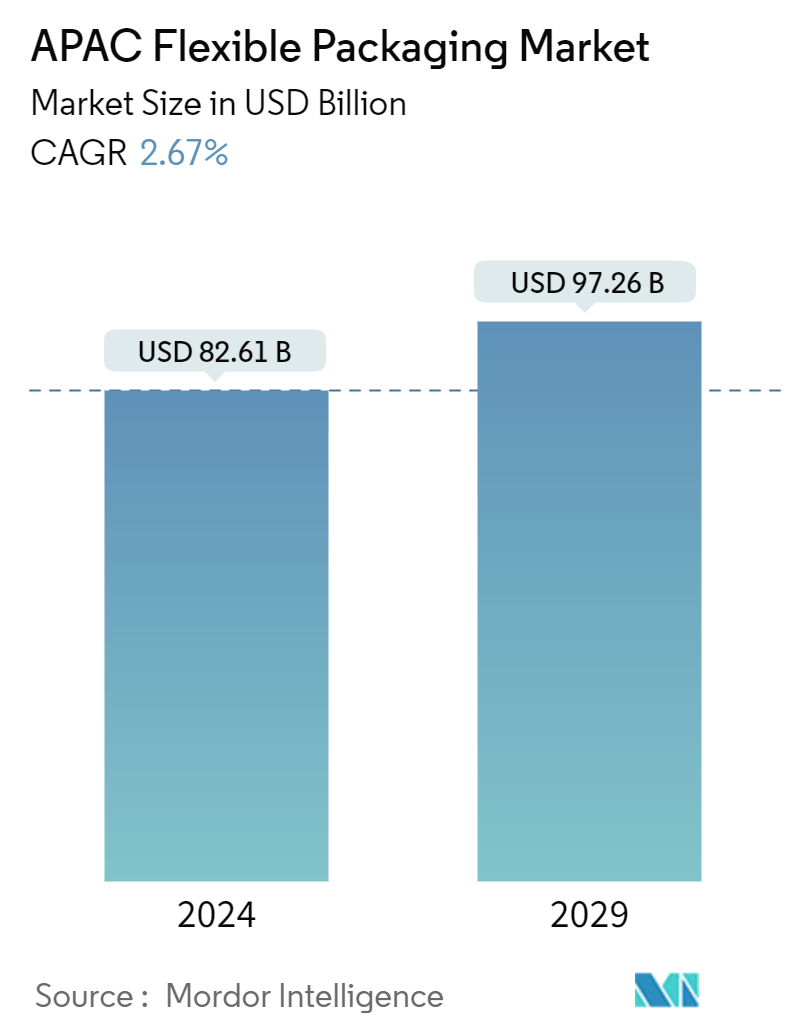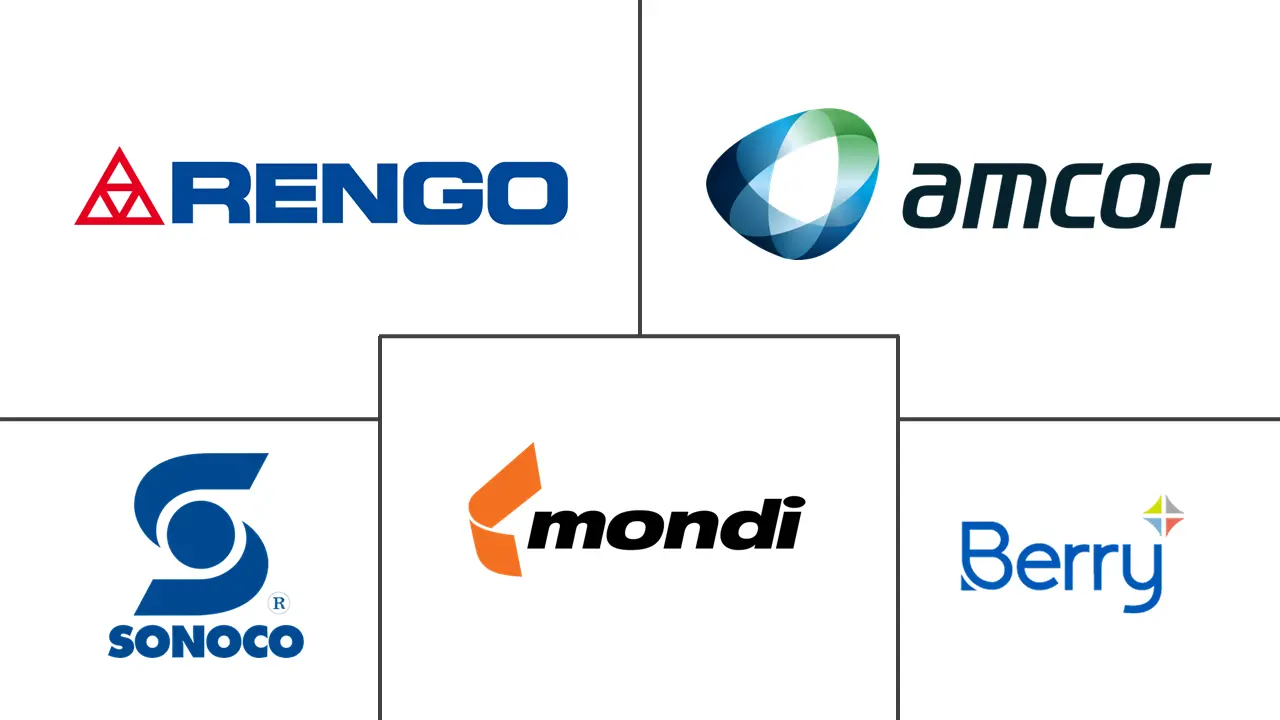Market Size of APAC Flexible Packaging Industry

| Study Period | 2019 - 2029 |
| Base Year For Estimation | 2023 |
| Market Size (2024) | USD 82.61 Billion |
| Market Size (2029) | USD 97.26 Billion |
| CAGR (2024 - 2029) | 2.67 % |
| Market Concentration | Medium |
Major Players
*Disclaimer: Major Players sorted in no particular order |
APAC Flexible Packaging Market Analysis
The APAC Flexible Packaging Market size is estimated at USD 82.61 billion in 2024, and is expected to reach USD 97.26 billion by 2029, growing at a CAGR of 2.67% during the forecast period (2024-2029).
- Flexible packaging in Asia-Pacific is expected to witness a stable growth rate during the forecast period. Some of the prominent vendors in the region are focusing on the ever-growing concern regarding environmental sustainability by adopting efficient manufacturing techniques throughout the three stages of the packaging life cycle: manufacturing, transportation, and disposal.
- As retail sales surge, markets tend to expand, introducing new products and broadening the reach of existing ones. Diverse industries, ranging from food and beverages to pharmaceuticals and personal care, utilize flexible packaging due to its versatility across various product categories. Consequently, a rise in retail sales stands to bolster various segments of the flexible packaging market. In 2023, Japan's retail industry achieved sales of approximately JPY 163 trillion, marking its highest value over the previous 15 years, as reported by METI (Japan).
- There is a considerable increase in domestic demand for flexible packaging in Asia-Pacific, owing to the rapid urbanization across emerging economies, such as China and India. Healthy growth across end users in the region is further driving the need for flexible packaging products, primarily in the wraps and pouches segment, majorly to address the small quantity retailing needs of the rising middle-income population in the region.
- The demand for flexible packaging products is mainly driven by millennial consumers in the region, as they have an avid preference for single-serving and on-the-go style food and beverage products. As these products are generally designed to be portable, durable, and lightweight, flexible packaging is a popular option. The fastest-growing areas of snack foods, both in terms of fresh items and processed foods, are expected to govern the demand for flexible packaging from the food and beverage industry. In 2023, Bingo and Kurkure had the highest market share of over 10% each among the puffed snacks companies in India. This was followed by Taka Tak, with a 6% market share during the same period.
- The beverage industry offers potential growth opportunities for flexible packaging across the region. Food companies are expanding their businesses in terms of geography and product lines to cater to this rising demand. For instance, Shou Quan Zhai, founded in 1760 and one of the oldest food companies in China, expanded into the beverage industry with a new line of ready-to-drink products.
- In January 2024, Chinese beverage brands made strides in international markets, embedding themselves into local communities by offering consistent quality products and services. Mixue Group, hailing from Zhengzhou in Henan province and boasting a network of over 36,000 stores globally, took a significant step by filing for an initial public offering in Hong Kong. Such expansion in the beverage industry may further propel market growth.
- The Russia-Ukraine War caused fluctuations in global oil prices, directly impacting the cost of raw materials used in flexible packaging, such as plastics, polyethylene, polypropylene, and other petrochemical derivatives. These materials are essential for producing films, pouches, and wraps used in flexible packaging. The increased cost of petroleum-based products raised the production costs for flexible packaging manufacturers in the region, leading to price increases for end products.
APAC Flexible Packaging Industry Segmentation
Flexible packaging refers to any package or component that can readily change shape when filled or used. Flexible packaging is mainly used for food, contributing to more than 60% of the total market, according to the Flexible Packaging Association. The market is witnessing healthy growth, as it was able to implement innovative solutions for the many packaging challenges it faced.
The Asia-Pacific flexible packaging market is segmented by type (pouches, bags, wraps, and other types), material (plastic, paper, and aluminum/composites), product type (pouches, bags, and wraps), end-user industry (food, beverages, pharmaceutical and medical, household and personal care, and other end-user industries), and country. The impact of macroeconomic trends on the market is also covered under the scope of the study. Further, the disturbance of factors affecting the market's evolution in the near future, such as drivers and constraints, has been covered in the study. The market sizes and forecasts are provided in terms of value (USD) for all the above segments.
| By Type | |
| Pouches | |
| Bags | |
| Wraps | |
| Other Types |
| By Material | |
| Plastic | |
| Paper | |
| Aluminum/Composites |
| By End-user Industry | |
| Food | |
| Beverages | |
| Pharmaceutical and Medical | |
| Household and Personal Care | |
| Other End-user Industries |
| By Country | |
| China | |
| India | |
| Japan | |
| Australia | |
| Rest of Asia Pacific |
APAC Flexible Packaging Market Size Summary
The Asia Pacific flexible packaging market is poised for steady growth, driven by increasing urbanization and the rising demand for convenient packaging solutions. This growth is particularly evident in countries like China and India, where rapid urbanization and a burgeoning middle class are fueling the demand for flexible packaging products, especially in the wraps and pouches segment. The market is also benefiting from the growing preference among millennial consumers for portable and single-serving food and beverage products. The food and beverage industry, particularly snack foods and frozen foods, is a significant contributor to this demand, with companies expanding their product lines and geographical reach to cater to evolving consumer preferences. Additionally, the beverage sector presents further growth opportunities, as companies like Shou Quan Zhai venture into new product lines such as ready-to-drink beverages.
The flexible packaging industry in the Asia Pacific region is also witnessing a shift towards sustainability, with companies adopting eco-friendly manufacturing techniques and materials. This trend is driven by the increasing consumer and regulatory focus on environmental sustainability, prompting manufacturers to explore innovative solutions like formable paper to reduce plastic usage. The COVID-19 pandemic posed short-term challenges, including supply chain disruptions and raw material shortages, but these issues are expected to be temporary. The Indian market, in particular, is experiencing robust growth due to factors such as rising per capita income, health consciousness, and changing lifestyle patterns. Government initiatives and stricter standards for recycled plastic use are further supporting the adoption of flexible packaging. Key players in the market, including Amcor, Berry Global, and Mondi Group, are actively investing in sustainable packaging solutions and innovations to meet the growing demand and regulatory requirements.
APAC Flexible Packaging Market Size - Table of Contents
-
1. MARKET INSIGHTS
-
1.1 Market Overview
-
1.2 Industry Value Chain Analysis
-
1.3 Industry Attractiveness - Porter's Five Forces Analysis
-
1.3.1 Threat of New Entrants
-
1.3.2 Bargaining Power of Buyers
-
1.3.3 Bargaining Power of Suppliers
-
1.3.4 Threat of Substitute Products
-
1.3.5 Intensity of Competitive Rivalry
-
-
1.4 Assessment of the Impact of Key Macroeconomic Trends on the Market
-
-
2. MARKET SEGMENTATION
-
2.1 By Type
-
2.1.1 Pouches
-
2.1.2 Bags
-
2.1.3 Wraps
-
2.1.4 Other Types
-
-
2.2 By Material
-
2.2.1 Plastic
-
2.2.2 Paper
-
2.2.3 Aluminum/Composites
-
-
2.3 By End-user Industry
-
2.3.1 Food
-
2.3.2 Beverages
-
2.3.3 Pharmaceutical and Medical
-
2.3.4 Household and Personal Care
-
2.3.5 Other End-user Industries
-
-
2.4 By Country
-
2.4.1 China
-
2.4.2 India
-
2.4.3 Japan
-
2.4.4 Australia
-
2.4.5 Rest of Asia Pacific
-
-
APAC Flexible Packaging Market Size FAQs
How big is the APAC Flexible Packaging Market?
The APAC Flexible Packaging Market size is expected to reach USD 82.61 billion in 2024 and grow at a CAGR of 2.67% to reach USD 97.26 billion by 2029.
What is the current APAC Flexible Packaging Market size?
In 2024, the APAC Flexible Packaging Market size is expected to reach USD 82.61 billion.

